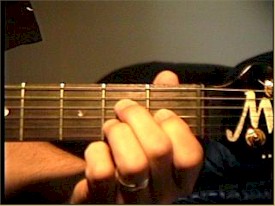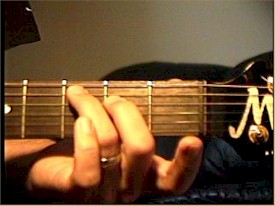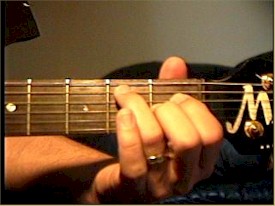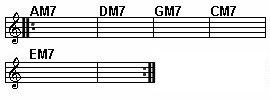Scroll through the lesson and click on notation/video/audio links to load the interactive players.
Please subscribe to get full access to all lessons for only $7.95/month PLUS 1 week free trial.

Riff Interactive lessons are
LESS expensive and
MORE interactive than alternatives!
More Info
|
|

Beginning Guitar
III - Lesson 2
Open Position Major 7 Chords Lyle: Before you start working on this
lesson, you check your tuning with me:
check your tuning
Lyle:
So far you've learned the major, minor and
dominant 7 chords in the open position. In this lesson
you'll learn the basic Major 7 chords in the open position.
These are very colorful sounding chords, rich with harmony. These rich in
harmony sounding chords don't work well with distortion, try using a clean sound
or an acoustic guitar with these chords. Rich sounding chords like this are
found in many types of music such as Jazz, Funk, R&B, Blues, Country, and Pop.
Probably wont find these chords in hard rock or metal too much, although Foo
Fighters and Zeppelin have used them in their songs. Lower case letters (m)
means minor, upper case (M) means major. Emaj7, EM7 = E major 7 Here's the A
major 7:
AM7

AM7
Lyle:
This is a 5 string chord, don't play the 6th string. Make sure all the notes
ring clearly.
Lyle: Next is the open
CM7:
CM7

CM7
Lyle:
The Major 7 chords are made from taking the 1st, 3rd, 5th, and seventh notes of
the major scale and playing them together in harmony. Again, that's a little
music theory you can impress your friends with ;-)
CM7
example
Lyle:
Next is the open position DM7 chord. Use your index finger to push down on all
three strings:
DM7

DM7
Lyle:
This technique of pushing down on two or more strings with one finger is called
"barring".
Lyle: The open DM7 chord is just a 4 string
chord, but it's ok if you hit the 5th string with it.
Lyle:
Next is the open position EM7 chord, which uses all 6
strings:
EM7

EM7
Lyle:
Last but not least, the GM7:
GM7

GM7
Lyle:
Notice you skip the 5th string. Your middle/2nd finger gently mutes the 5th
string.
Lyle: Now that you have been introduced to these
fine chords, it's time to try playing them in a
progression!
chord
progression 1

Lyle: I want you to strum once on beat 1 for each
measure. Remember to tap your foot to the beat and count to 4 during each
measure:
chord
progression 1
chord
progression 1
Lyle:
The EM7 chord gets two measures worth before the progression starts
over. Here's a looping jam track you can use to
play along with:
Jam Track for progression 1
Lyle:
It's a little fast but you can do it! For the average beginner, this exercise can
be tough because you're playing 5 new chords and switching every 4 beats. It
can be a lot to memorize, but it's a good challenge!
Lyle: Here's another chord progression for you to
try. This time it uses a few of the other chords you have learned from the last
few lessons:
chord
progression 2

chord progression 2
chord
progression 2
Lyle:
Here's a looping jam track for this progression:
Jam
Track for progression 2
Lyle:
Notice how the combination of different chords create a rich harmonic and
melodic sound in progression 2?
Joel: Reminds of George Harrison or Beatles.
:)
Lyle:
Exactly! It's from a Riff Interactive CD-ROM I made called Rock Legends I -
George Harrison Style. Yes, they were all about harmony and
melody, so they used these colorful
chords.
Lyle: Well that's about it for this lesson. You
have new chords to memorize now and two progressions to master. Make these
chords sound good, then take a break before going on to the next lesson. If you
have questions about this lesson, email me at
Lyle@theguitar.net. Thanks.
|
<< load notation from left
|
|
<< load audio from left
|
<< load audio from left
|